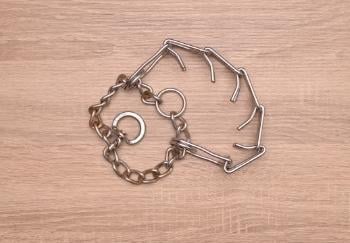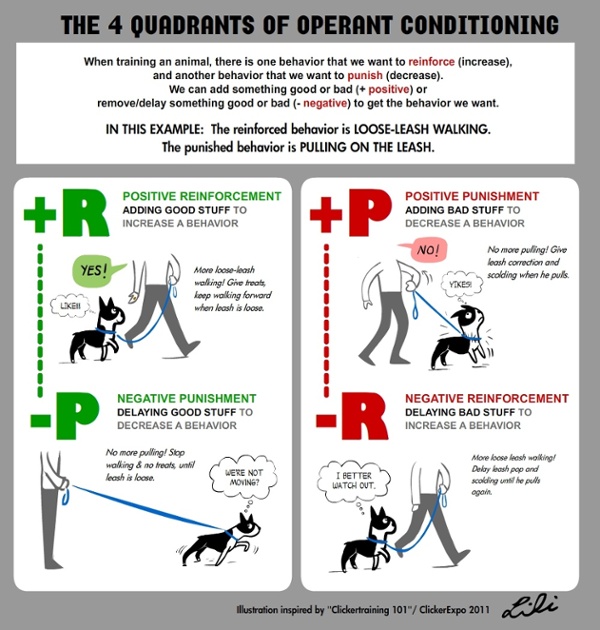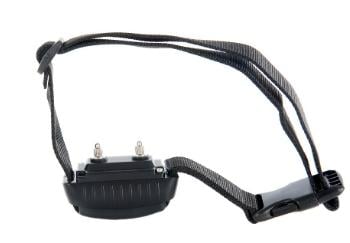 In the dog training world, there is a constant debate about whether the use of aversive methods and tools has a place in training our dogs.
In the dog training world, there is a constant debate about whether the use of aversive methods and tools has a place in training our dogs.
Not so long ago, it was widely accepted that training dogs to behave needed a firm hand and a dominant state of mind. Dog training and behavior books touted alpha rolls and leash corrections as the only way to make your dog stop jumping on people or pulling on leash.
Dog owners never really questioned these methods because they seemed to work – for the most part. But these techniques worked for the wrong reasons, and more often than not, the bad behavior was never “fixed” — it was simply suppressed.
What are Aversives?
How do Aversives Work?
Why You Should Avoid Aversives
Busting Dog Training Myths
Finding a Trainer Who Doesn't Use Aversives
More recently, famous television personalities use phrases like “calm submissive state” and “pack leader” to encourage the use of such methods. But there have been many unintended consequences from these techniques, and the dogs subjected to these methods and tools have paid quite the price.
Fortunately, as the study of animal behavior has advanced, more dog trainers and behaviorists are opting to go the force-free and positive reinforcement route. The focus is shifting to setting our dogs up for success. Popular trainers on television and online are now trying to educate dog owners about better ways to understand, communicate, and train their dogs.
Leaders in the pet health and behavior industry such as The American Veterinary Society of Animal Behavior, the Certification Council for Professional Dog Trainers, and the Association of Professional Dog Trainers advocate for the use of least-invasive and minimally-aversive training methods.
 What are Aversives in Dog Training?
What are Aversives in Dog Training?
In dog behavior terminology an “aversive” is something unpleasant that is used to suppress or diminish an unwanted behavior. An aversive can be an unpleasant sound, a physical correction, the pain caused by a shock collar or prong collar correction, or a harsh scolding. It's considered an aversive if it's something your dog will work to avoid in the first place or will work to stop in the moment.
Humans work to avoid aversives all the time with our own behavior. We don’t touch a hot stove with our bare hands to avoid the pain of being burned. We show up to work to avoid getting fired. Children get an aversive physical punishment when they are spanked by their parents for misbehaving (although corporal punishment is becoming less acceptable in many cultures – for very good reasons).
Aversive dog training tools include:
- Prong collars
- Choke collars
- Citronella spray collars
- Shock collar (also known as e-collars)
- Invisible fence collars, such as the Halo Smart Dog Collar
- Shaker cans (soda cans filled with pennies or rocks)
- Spray bottles (Note: some dogs don't find this aversive — I've met many dogs who love to catch the water sprayed. But the intent of their use makes them an aversive tool)
Some trainers who rely on these aversive tools will argue that the prong collar correction or the shock from the electric collar isn’t causing pain. But think about it — if they didn’t cause pain or discomfort to the dog, then they wouldn’t work to increase or decrease the behavior. The avoidance of pain, or wanting the pain to stop, is what is motivating your dog to stop pulling or to come when called. So even if the claim is that "it's like a TENS unit," it's either aversive enough to make the dog want to stop it, or it's not working as an aversive at all — so there's no point in using it.
Aversive dog training techniques include:
- Physical corrections
- Leash popping (even on a flat collar)
- Hitting
- Alpha rolls and Dominance downs
- Yelling
- Confrontational staring or acting in a threatening manner with body language
- Holding a dog's mouth closed
- Poking or trying to "simulate a mother dog's bite" with fingers
Whatever a dog finds emotionally or physically unpleasant (or painful) and works to avoid is an aversive. What I think is most important, however, is to specifically avoid tools and techniques that were created with the intent of causing discomfort or pain. Anything that relies on the "Do this, or else ..." isn't a humane or ethical training tool or technique to use, and can be extremely detrimental to your relationship with your dog.
How Do Aversives Work?
When using aversives when training your dog, you are using what is called Positive Punishment and/or Negative Reinforcement. Positive Punishment and Negative Reinforcement are two of the four quadrants of operant conditioning. These two quadrants should be the least relied upon when trying to change your dog's behavior, and many trainers and behaviorists work to avoid using them altogether in their programs. Studies are exposing the unintended consequences of these methods, including increased aggressive behavior, stress, and fear.
The words Positive (+) and Negative (-) aren’t talking about any emotional connotation, but instead mean we are either adding ("Positive") something or removing ("Negative") something from the situation. Punishment indicates that the likelihood of the behavior will decrease, while Reinforcement means the behavior will likely increase in frequency.
Positive Punishment = adding something to make a behavior decrease
Negative Reinforcement = removing something to make a behavior increase

For example, you could add a strong prong collar correction when your dog pulls on leash. They are less likely to pull on leash in the future to avoid the pain of the prongs on their neck. This is positive punishment.
You could call your dog to come and shock them continuously with their e-collar until they turn and come back to you. Next time you call your dog, they will respond to the cue faster to make the pain of the shock stop sooner or avoid it altogether. This is negative reinforcement in action.
Test Your Quadrant Knowledge in this quick quiz:
Why You Should Avoid Aversives
Aversives may work. Positive punishment (using aversives) is a part of the operant conditioning quadrant. But here's the thing: they aren’t necessary. In many cases, they are simply inhumane. When considering which techniques or tools to use with your own dog, always ask yourself "Is this necessary?" More often than not, there is a better way.
If your dog trainer relies on aversives, they are either unaware of (or simply ignoring) the most recent advances in behavioral science and are possibly too impatient to take advantage of more effective and humane training methods and tools.
Let’s look at some reasons why you should avoid using aversive training methods with your dog:
There are More Effective Training Methods and Tools Available
Positive reinforcement training has been shown to change dog behavior more effectively than positive punishment. There are even studies done that prove this, such as this one, which states, "Our results demonstrate through direct evidence from real life situations, that the reward-focused training was, indeed, more efficient than methods which included potentially aversive stimuli such as electric stimuli or excessive lead pressure."
Dogs learn faster and are more eager to train if they are being told what to do and rewarded for correct responses. Imagine starting a new job and only being told what not to do. You wouldn’t learn how to do your job very quickly, if at all! Positive reinforcement tells your dog when they get it right, which makes it easier for them to make the right choice again and again.
Imagine starting a new job and only being told what NOT to do.
You wouldn’t learn how to do your job very quickly, if at all!
Clicker training has gained popularity with the rise of positive reinforcement training. A clicker is a tool used in training to communicate clearly to a dog that they’ve earned a food treat by performing a certain behavior. This tool can help you practice positive reinforcement training more effectively, and is faded out over time as your dog learns, meaning you don’t have to rely on having your clicker in hand (or treats) for your dog to behave. Instead of a clicker, many dog owners use a marker word instead, such as "yes!" It works the same way as a clicker, precisely marking a behavior so the dog knows what they got right and what predicts reinforcement.
Some dog owners rely on prong and choke collars because they feel they cannot physically control their dog otherwise. There is a variety of collars and harnesses that work just as effectively as aversive collars, without causing discomfort, pain, or injury to the dog, and are more comfortable for the human handler to use.
Would You Use a Prong Collar on a Tiger?
Animal trainers and caretakers around the world who work with large non-domesticated animals simply cannot rely on aversive tools and methods. Imagine trying to control a tiger with a prong collar during a routine veterinary exam or putting a shock collar on a walrus for training! You'd either get your face ripped off or they'd simply swim away. If trainers can teach complex behaviors to these animals using positive reinforcement tools and methods, we can certainly use them with our pet dogs.
It's amazing to see the effectiveness of positive reinforcement techniques with exotic animals — check out these three videos to see it in action:
There is no reason to use aversive training methods and tools when there are more humane and easy-to-use alternatives readily available. It's up to us to advocate for our dogs and not stoop to the level of physical punishment or force to get what we want, no matter how convenient it might seem.
Long-Term Reliance on Aversive Tools
Aversive tools like bark collars, choke, and prong collars don’t change your dog’s behavior, at least in a way that’s effective and long-term. In most instances, they simply suppress the behavior when the aversive is present. This happens when dog owners rely on prong or choke collars while walking their dog on leash. As long as their dog is wearing their prong collar, they don’t pull because they know they will receive a correction. (On a side note, I can't tell you how many dogs I've seen wearing prong collars that still pull like a freight train.) Can you guess what will happen if they go out for a walk wearing a flat collar?
There are many dog trainers who claim they have “fixed” a dog that previously pulled on leash by throwing a prong or choke collar on them and calling it good. But without taking the time to reinforce walking politely on leash and not pulling, the dog hasn’t learned anything other than not to pull when they’re wearing that collar.
Another example of this would be bark collars, whether shock (e-collars) or citronella spray. What's most disheartening about these tools is that it's punishing a normal dog behavior. And bark collars can also have extremely detrimental effects on dogs who associate the thing they were barking at with the aversive consequence, causing long-term fear, anxiety, reactivity, or aggression issues with those particular stimuli. And when the collar isn't being worn, a dog will bark (because that's what they do) — leading again to long-term reliance on wearing the collar. Suppression at its finest.
Your dog’s good behavior shouldn’t rely on whether they’re wearing a specific kind of collar. It’s much more rewarding as a dog owner to see your dog make good decisions because you’ve taught them what behaviors are rewarding and make you happy!
 Unintended Consequences
Unintended Consequences
The use of aversives can create very strong negative associations in your dog’s mind, and it’s not always the association you’re wanting to create. These kinds of associations increase your dog’s anxiety and fear of certain stimuli, which can result in fear reactivity and aggression. Studies have shown an increase in aggressive behavior in dogs who are trained with positive punishment and aversive tools.
For example, if you are using an electric shock collar to stop your dog from barking, the desired association is that a bark equals a shock, therefore we want the dog to learn: don’t bark and you won’t be shocked. However, if your dog barks when they see another dog pass by the yard and receives a painful correction, did they associate the bark with the shock? Or the presence of the other dog? If you give your dog a correction via their choke collar when they pull to greet another dog, did they associate the correction with pulling? Or with the presence of the other dog?
You cannot know what association your dog is making at the moment since you aren’t in their brain. But you can do everything possible to prevent negative associations by not using aversives in the first place.
Aversives Kill Your Dog’s Motivation to Train
Training should be fun for both dog and owner! When your dog is having fun, they’re willing to work harder and more often. Constantly waiting for your dog to make a mistake so you can correct them doesn’t sound like much fun at all, for you or your dog. And the less fun and rewarding something is, the less your dog will want to do it.
Using positive punishment training motivates your dog to avoid an aversive altogether or make an aversive stop. Not the kind of life most people want for their dogs!
Would you rather have a dog who is only doing something you asked for so you don’t hurt them? Or one who happily engages with you and offers good behaviors because they are having a great time?
Using punitive methods also makes it harder to increase the quality of training responses from your dog. Dogs will only offer enough of a behavior to avoid a correction; they’ll do the least amount required of them to avoid that collar correction or shock.
Aversives suck the motivation to train right out of your dog!
Want to see the difference in body language and motivation levels between dogs trained with aversives versus positive reinforcement? Check out this collection of Shock Collar versus Force Free Video Examples.
The Danger of Dominance
 Perhaps the most compelling reason for most dog owners to avoid aversive training methods like alpha rolls and dominance downs is that it puts them in direct physical danger.
Perhaps the most compelling reason for most dog owners to avoid aversive training methods like alpha rolls and dominance downs is that it puts them in direct physical danger.
An alpha roll is when the handler uses force to push the dog down into a vulnerable position on their side or on their back while standing or laying over them in a threatening manner until they “submit.”
This places the handler’s face, hands, and arms very close to the dog, and if the dog decides to try and escape by responding defensively, can you guess what they’ll aim for? Ouch! You might have seen this technique used by popular TV trainers, but they purposefully have their production team edit out the dog bite footage (or keep it in for shock value).
A dog trainer should always set a dog up for success and work to prevent a bite history. Intentionally forcing a dog into a situation where they feel like they have no choice but to bite is incredibly irresponsible and leads directly to euthanasia of dogs for behavioral issues that were directly caused by human actions.
These techniques are also extremely difficult to perform “correctly” and consistently. Grandma won’t be able to alpha roll the family dog as well as her strong grandson, and neither of them should have to put themselves in such an unsafe position in the first place.
These techniques force the dog into a very tumultuous state of mind; if they can’t run away from the threat, they must choose between fighting or a state of learned helplessness and submission in order to escape the aversive.
If they choose to react defensively and try to bite you to escape, you’ve just reinforced aggression in your dog. If they choose learned helplessness (also known as a calm submissive state), you’ve reinforced fear and anxiety and taught them to suppress appropriate warning signals such as growling. This leads to a dog that seemingly “bit out of nowhere.”
This video is a news story showing the fallout of using an alpha roll. It breaks my heart to see a dog being abused this way in the name of "training," and I'm not surprised that the outcome was increased aggression:
There's No Such Thing as Being the "Alpha" for Your Dog
Unfortunately, the idea that a human must assert dominance over their dog and "be the alpha" has yet to fade from our collective memory, and many trainers claim you must punish your dog to establish your place as leader of the pack. They’re simply wrong. In fact, Dr. David Mech, wolf expert and one of the original researchers behind pack theory, has since denounced it. You can train your dog just as effectively — and have more fun doing so — by using positive reinforcement training methods. Your dog will thank you for it!
Busting More Myths
Positive does not mean permissive
Positive and force-free training doesn't mean that dogs don't have structure in their routines or boundaries in their environment. There are consequences for unwanted behavior. But it's a different kind of consequence than the aversives I discussed above. A good force-free trainer will utilize what's called negative punishment.
Positive Reinforcement = adding something your dog likes to make a behavior increase
Negative Punishment = removing something your dog likes to make a behavior decrease
But an even better force-free trainer will set up an environment where a dog has less likelihood of making mistakes and performing unwanted behaviors. This means there are more opportunities to reinforce the wanted behavior, leading to a dog who chooses the right thing rather than misbehave. Once we have a solid foundation built, that's when we begin to generalize and practice these behaviors in different environments and contexts.
So yes, positive reinforcement and force-free training sometimes means the training process takes more time than "balanced" or aversive training. But in my experience, this hasn't been the case. Most often, delayed success in training is due to the human side of the equation needing more training in management, mechanics, and timing. And if I have to spend a couple of hours more working with a dog without causing them pain, discomfort, or fear? Well, that's more than worth it to me and better for the dog.
"You can't fix aggression with positive training."
This is simply untrue. I've seen many aggression cases resolved with positive reinforcement training, whether it's resource guarding, dog-dog aggression, human-directed aggression, etc. I've worked successfully with many aggression cases. There are many seminars and conferences every year exhibiting case studies of aggression cases resolved with positive training only. If you're interested in learning more about how to work on dog aggression without resorting to aversives, I highly recommend Michael Shikashio's work at AggressiveDog.com.
Certain Breeds Need "Balanced" Training
Dogs that are deemed "high drive" breeds, such as bully breeds, Belgian Malinois, etc., are often used as examples of dogs that require aversive methods or tools to control or train. What's amazing is the success of positive trainers with these breeds, especially in protection dog sports such as Schutzhund, mandioring, or Police K9 training — areas where aversive training has been the mainstay for decades. No, certain breeds do not require aversive training more than others. Certain breeds DO require different management and appropriate outlets for different instinctual drives, however.
Interested to see how positive trainers work with high drive dogs? Check out Denise Fenzi, Steve White (a Police K9 trainer), and Nando Brown.
Finding a Dog Trainer Who Doesn't Use Aversives
In an unregulated industry, it can be difficult to connect with a trainer whose training methods and philosophy match your own. The first tip for finding and vetting a dog trainer to work with you and your dog is to look for education and certifications. But certification isn't a guarantee in and of itself. There are many different certifications for dog trainers, some that even include the use of aversives in training methods. Start by first learning what dog training certifications and designations are and then be sure to ask a potential trainer more about how they train.
Check out "Alphabet Soup: What Does That Dog Trainer Certification Mean" and then read "What You Should Ask a Dog Trainer (and What Their Answers Should Be)" for more info. And if you ever need help finding a local force-free trainer near you, let me know in the comments — I'm happy to help you find someone in your area.
One last myth to bust: There is technically no such thing as a "positive only" dog trainer. A force-free trainer is technically utilizing two parts of the operant conditioning quadrant — positive reinforcement and negative punishment. There are consequences, but these consequences are not based on physical corrections, intimidation, or other aversives. However, there is a training setup where we can create "errorless learning" opportunities, and while beneficial in certain training contexts, it is difficult to create in day-to-day life. You can read more about errorless learning here.




